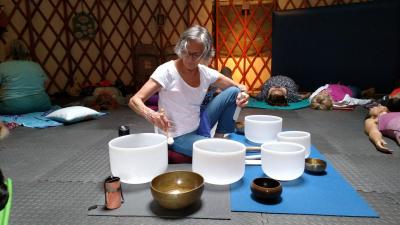Feeling the Vibes with Sound Therapy
Tuning into Nancy Bowden's sound and energy healing
Invitations to attend sound baths and sound healing sessions seem to be popping up everywhere. If you haven't heard the buzz, this recently revived ancient practice goes a bit deeper than just listening to your favorite songs to boost your mood. However, the effects have similar origins.
We already know that some sounds or types of music make us feel better than others. We understand that upbeat or melancholy songs can affect our emotions. Our bodies take cues from these sounds and rhythms, knowing when to get energized and when to relax.
Sound can have both psychological and physiological effects because the vibrations are both heard and felt by the body. Growing research suggests that when used in a directed way, sound can help us reduce stress and promote our own healing.
"Everyone has a signature vibration. When we become stressed, fearful, angry or depressed, we become out of tune with ourselves and life itself," said Nancy Bowden, a Reiki master/teacher, and sound and energy healer trained in Singing Bowl Therapy by Shree Krishna Shahi of Nepal, among other energy modalities.
"Sound and vibration therapy can be used to re-tune us to health," Bowden said. "Sound effects us on a cellular level opening up the flow of energy to bring us back to vibrational alignment."
Sound healing puts your body into a parasympathetic state. When you are in a sympathetic state (fight or flight), whether that's from stress or pain, your body is surging with cortisol and inflammation. The sound waves or vibrations created by certain tools, such as gongs, tuning forks, and singing bowls, can actually alter your brainwave frequencies.
"Sound therapy creates an environment for relaxation where the body can heal itself," Bowden said. "Sound creates a mandala that moves through your energy field releasing negative thoughts, feelings, and emotions which affect all systems in the physical body. It has been known to reduce stress, improve concentration, reduce blood pressure, stimulate one's life force energy, improve attitude and spiritual awareness, and much more."
There are many different types of sound therapy. Bowden primarily uses crystal and Tibetan singing bowls and tuning forks in her practice. She says that anyone with the tools can give a sound bath. You can even give one to yourself.
"A sound bath is being immersed in the vibrations of singing bowls, gongs, drumming, ringing a bell, or even turning your music up and dancing to your own beat. It's allowing the sound to fully embrace and surround you so you enter an expanded space of awareness and relaxation," Bowden said.
Bowden recommends that when seeking sound therapy professionally it is best to work with someone who has some training and experience. She says she integrates her training to resonate with the individual.
Experiencing a professional sound bath or sound therapy session is much different than giving yourself your own session. Participants have said their experience changes each time they attend a session. Many participants have said they leave a sound bath feeling balanced, relaxed, refreshed, creative, and more self-aware.
"How it feels depends on what modality is used," said Bowden. "Tibetan bowls are softer, while crystal bowls are louder. Tuning forks are subtle. The results are the same. In my sessions people either sit in a chair or lie comfortably on the floor. Some people say they see colors, others don't. What really happens is people go deep within themselves to let go of stressful thoughts, worry, and fear. Most return from the journey with more mental clarity and relaxation."
Bowden said that she works to create a conscious connection to the body and mind. "Sound has the power to heal our wounds, change consciousness and re-unite us with the natural harmonies of the universe. An ancient technique with a modern twist."
Amy VanScoter is a registered yoga teacher at School House Yoga and a wellness program coordinator. She can be reached at avanscoter@gmail.com.




